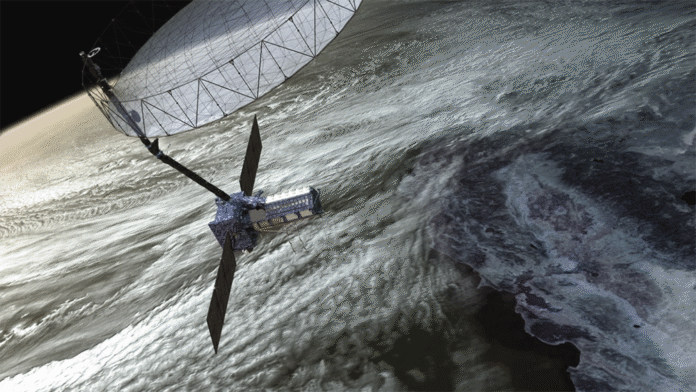What is NISAR? NISAR is a special satellite that India’s space agency ISRO and America’s NASA have built together to observe and study Earth from space. It stands for NASA–ISRO Synthetic Aperture Radar.
Why is NISAR Special?
NISAR is different from other satellites because it uses two powerful radar systems that can see through clouds, smoke, and even dense forests. It works both during the day and at night. This is the first time any satellite will use dual-frequency radar—L-band and S-band—together.
The satellite costs about 1.5 billion US dollars, making it one of the most expensive Earth observation satellites ever created. But its advanced technology justifies the cost. It can monitor changes on Earth with great precision.
What Will NISAR Do?
Once in space, NISAR will circle the Earth and take detailed images every 12 days. It will track changes in the Earth’s surface and help in the following areas:
It will detect natural disasters such as earthquakes, landslides, floods, tsunamis, and volcanic eruptions. It will also observe ice-sheet collapses in polar regions and monitor changes in forests and water bodies due to climate change.
NISAR is different from other satellites because it uses two powerful radar systems that can see through clouds, smoke, and even dense forests. It works both during the day and at night. This is the first time any satellite will use dual-frequency radar—L-band and S-band—together
For agriculture, NISAR will help by mapping surface soil moisture around the world every 6 to 12 days, which is useful for farmers to decide when to water crops.
Urban planners can also benefit from NISAR as it will track the growth of cities and help assess the stability of buildings and land.
Who Built the Satellite?
NISAR is a true partnership between India and the United States. NASA provided the L-band radar system, GPS receivers, data recording hardware, and communication systems that send information back to Earth.
ISRO built the main satellite structure, the S-band radar system, the GSLV Mark II launch vehicle, and will provide launch and ground support services. The entire satellite was assembled and tested at ISRO’s facilities in Bengaluru by teams from both countries.
How Much is India Spending?
Although the total cost of the NISAR mission is about 1.5 billion dollars, India’s share is much smaller. India is responsible for building the satellite bus, the S-band radar, and launching the satellite. NASA has provided the more expensive L-band radar and other key instruments. This smart partnership allows India to access advanced technology while keeping its investment low.
Launch Vehicle Details
NISAR will be launched aboard India’s GSLV Mark II rocket. This rocket is around 49 metres tall—about the height of a 15-storey building—and has three stages that work one after the other to push the satellite into space. It can carry payloads weighing up to 2,500 kilograms. This rocket will launch NISAR from the Satish Dhawan Space Centre in Sriharikota.
Which Orbit Will NISAR Use?
NISAR will be placed in a Low Earth Orbit at an altitude of about 747 kilometres. This is called a Sun-Synchronous Orbit. In this orbit, the satellite will pass over the same location on Earth at the same time every day, which ensures it captures images under similar lighting conditions. This orbit is ideal for regularly observing changes on the Earth’s surface.
NISAR carries a huge antenna that opens like an umbrella once in space. The antenna is 12 metres wide—about the size of a basketball court. It can detect changes on Earth as small as 5 to 10 metres. That means it can spot something the size of a small house from space
Mission Life
The primary mission life of NISAR is at least three years. However, scientists expect it to work for five to seven years or even longer. During its lifetime, NISAR will collect thousands of images and help scientists track long-term changes on Earth. It will observe land and ice-covered surfaces globally every 12 days and revisit some areas every 6 days.
Journey to Space
Before its launch, NISAR faced a technical issue where its large antenna was getting too hot. To fix this, the satellite was sent back to California, where engineers applied a special reflective coating to manage heat better. After these fixes, NISAR arrived at the launch site in Sriharikota on May 15, 2025. It is now being prepared for launch by the end of July 2025.
Amazing Features of NISAR
NISAR carries a huge antenna that opens like an umbrella once in space. The antenna is 12 metres wide—about the size of a basketball court. It can detect changes on Earth as small as 5 to 10 metres. That means it can spot something the size of a small house from space.
All the data collected by NISAR will be freely available to users around the world. In normal cases, it will be available within one to two days. In case of natural disasters, the data will be made available within a few hours.
How Will This Help Students and Common People?
NISAR’s data will be free and open for everyone. Students can use the images and data to study geography, climate change, and environmental science. Scientists and disaster management agencies can use this data to prepare better responses during emergencies.
NISAR is a proud moment for India. It shows how Indian scientists are capable of working on big international projects and advanced space technology. This mission also helps India improve its knowledge about its own land—monitoring the Himalayas, checking the condition of cities, and understanding monsoon effects
Farmers will benefit too. With detailed soil moisture maps, they can manage water use and improve crop yields. Urban planners and environmental researchers can study land changes, forest loss, glacier movements, and river erosion using NISAR’s regular and reliable images.
Why Should We Be Proud?
NISAR is a proud moment for India. It shows how Indian scientists are capable of working on big international projects and advanced space technology. This mission also helps India improve its knowledge about its own land—monitoring the Himalayas, checking the condition of cities, and understanding monsoon effects.
It is also a perfect example of how two countries can come together to work for the betterment of the planet. This collaboration strengthens the bond between India and the United States in the field of space research.
What Happens Next?
Once launched at the end of July 2025, NISAR will begin its important mission. Over the next few years, it will give us a better understanding of Earth’s changes, help in managing disasters, support farming, and contribute to climate research.
For young students and future scientists, NISAR is a symbol of what can be achieved when nations work together with a shared vision for a better planet.
-The author is a Defence, Aerospace & Political Analyst based in Bengaluru. He is also Director of ADD Engineering Components, India, Pvt. Ltd, a subsidiary of ADD Engineering GmbH, Germany. You can reach him at: girishlinganna@gmail.com. The views expressed are personal and do not necessarily carry the views of Raksha Anirveda






